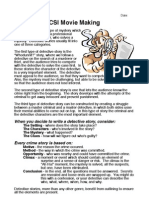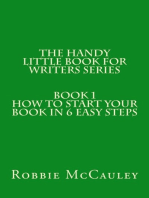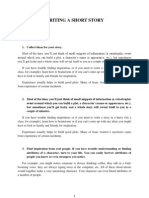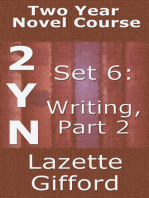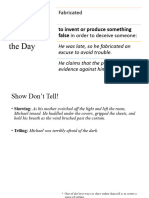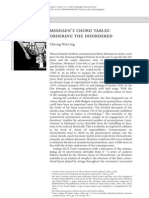0 ratings0% found this document useful (0 votes)
45 viewsStory Check
Story Check
Uploaded by
Alan HoskerEnsure your story has all the necessary ingredients
Copyright:
© All Rights Reserved
Available Formats
Download as PDF, TXT or read online from Scribd
Story Check
Story Check
Uploaded by
Alan Hosker0 ratings0% found this document useful (0 votes)
45 views12 pagesEnsure your story has all the necessary ingredients
Copyright
© © All Rights Reserved
Available Formats
PDF, TXT or read online from Scribd
Share this document
Did you find this document useful?
Is this content inappropriate?
Ensure your story has all the necessary ingredients
Copyright:
© All Rights Reserved
Available Formats
Download as PDF, TXT or read online from Scribd
Download as pdf or txt
0 ratings0% found this document useful (0 votes)
45 views12 pagesStory Check
Story Check
Uploaded by
Alan HoskerEnsure your story has all the necessary ingredients
Copyright:
© All Rights Reserved
Available Formats
Download as PDF, TXT or read online from Scribd
Download as pdf or txt
You are on page 1of 12
Course: Writing Fundamentals: The Craft of Story
Chapter 1 What Is a Story?
Story Check
Here are some quick questions you can ask yourself when you begin to writeor rewriteyour
own story. These questions will help you make sure your story stays on track.
Questions
1. What happens?
2. Who does the plot affect?
3. What is your protagonists goal?
4. How does your protagonist change?
Practice
Practice writing a strong premise.
Take a minute and make this weak example sing. Feel free to change, add or get rid of any of
the particulars in this. And remember, there are no right answers; your imagination rules. Enjoy!
Heres the edgling premise:
Roger is a middle-aged dentist whose wife disappears. Hes not sure whether she left him,
or if something sinister happened to her. She was a dog groomer and insisted on working
out of their apartment, even though hes severely allergic to dogs. Roger was constantly
sneezing, which worried his patients, who thought he was coming down with a cold and
would give it to them. Lately, hed been losing business. His wife wanted him to take time
off so they could go to Hawaii and rekindle their relationship, but thanks to his dwindling
practice, he couldnt afford to take time off. Now shes gone, and hes not sure what to do.
Page 1 Chapter 1 What is a Story?
Course: Writing Fundamentals: The Craft of Story
Chapter 2 Hooking Your Reader
Story Check
When youre checking the opening paragraph or rst page of your story, here are the four
questions to ask to make sure you are hooking your reader.
Questions
1. Will the reader know whose story it is?
2. Is something happening, beginning on the rst page?
3. Does something hang in the balance?
4. Is enough of the big picture visible, from the get-go, to give us a sense of where the
story is going?
Practice
Now you give it a try.
Your work is cut out for you. Remember there are no right answers; let your imagination be
your guide. This one is tough, because other than the fact that Francesca is probably the
protagonist, theres neither hide nor hair of the other three elements anywhere on the page as
yet. Thats your mission, should you decide to accept it.
Francesca was already in her pajamas when the doorbell rang, so she was curious and
cautious as she opened the door. Imagine her surprise when she saw a deliveryman
holding an enormous bouquet of beautiful, fragrant yellow roses. Miss Yates? he asked.
Francesca beamed. Yes, she said, Thats me. Theyre gorgeous!
Page 2 Chapter 2 Hooking Your Reader
Course: Writing Fundamentals: The Craft of Story
Chapter 3 All Stories Make a Point
Story Check
Heres a nifty checklist to help you zero in on what your story is actually about.
Questions
1. What is your storys point?
2. What is your storys theme?
3. Do the protagonists inner issue, the theme, and the plot work together to answer
the story problem?
4. Can you sum up what your story is about in a short paragraph?
Practice
Your goal is to dive into this series of events and give this what its missing: a point. Good luck!
Valerie has spent her entire life as a cyclist, riding her bike back and forth across country,
raising money for the causes she believes in. Then she gets caught in a ash ood in a
small Midwestern town and loses her bike, her backpack, everything. Because she has no
money, she has to get a job to save up enough for a new bike. While there, she falls in love
with a local cop and they have a great time for about six months, until she has enough
money to buy the bike shes always dreamed of and she hits the road again.
Page 3 Chapter 3 All Stories Make a Point
Course: Writing Fundamentals: The Craft of Story
Chapter 4 Feeling What the Protagonist Feels
Story Check
Use this handy list of questions to make sure that your reader is able to feel what your
protagonist is feeling.
Questions
1. Is the reader aware of your protagonists specic expectations, so we can tell whether
theyre being met or not?
2. Does everything that happens affect your protagonist emotionally in the moment?
3. Does your protagonist react to everything that happens?
4. Can the reader see the causal link between what happened and why your protagonist
reacted the way she did?
5. If youre writing in the rst person, does everything reect your protagonists point of view?
Practice
Can you improve this very rough draft by showing us how Rick, the protagonist, is reacting to
whats happening? Right now, this scene is noteworthy for what it doesnt tell us. Your job is to
imagine the story beneath whats written here.
Feel free to rewrite the scene from scratch, weaving in as much back story as you like, to
give us a really good idea of how Rick is making sense of all the surprising things that are
happening.
Rick watched Daisy walking solemnly toward the altar. He remembered the day she was
born, his rst child. Now she was getting married. Hed always thought hed walk down
the aisle with her, but shed wanted to go alone. He glanced at Tom, waiting for her in
front of the justice of the peace, frowning. Out of the corner of his eye Rick saw his wife
May wipe away a tear. He squeezed her hand. Then he heard a gasp from the back of the
room. He turned to see a tall gaunt man standing in the doorway. Gus, Daisys rst love,
whod disappeared without a trace three years ago. Boy, what a surprise, Rick thought.
Page 4 Chapter 4 Feeling What the Protagonist Feels
Course: Writing Fundamentals: The Craft of Story
Chapter 5 All Protagonists Have a Goal
Story Check
Here are a few questions to help you make sure that your protagonist has a goal worthy of an
entire story.
Questions
1. What is my protagonists external goal?
2. What is my protagonists internal goal?
3. Do these goals force them to face a specic longstanding problem or fear?
Practice
Take a minute and practice on the following rough draft. Your goal is to pinpoint whats missing
here, and then let your imagination ll in the blanks. Todds fate is in your hands. Will he get to
waltz off into the sunset, or end up living in a cardboard box? Its your call!
Todd works at a busy fast food restaurant, ipping burgers, when what he really wants to
do is become a ballroom dance instructor and get to wear those shiny black dance shoes.
So at night he teaches himself to waltz by watching old Fred Astaire movies, even though
it really annoys his mean downstairs neighbors, who keep complaining to the landlord
about the loud music and what sounds to them like elephants stomping. But mastering
Astaires moves is so important to Todd he decides that even if it gets him evicted, so be it.
Page 5 Chapter 5 All Protagonists Have a Goal
Course: Writing Fundamentals: The Craft of Story
Chapter 6 Uncovering Your Protagonists Inner Issue
Story Check
Here are ve key questions that will help you zero in on the root of your protagonists desires
and fears.
Questions
1. What is the source of the fear and the desire that the plot will force your protagonist
to struggle with?
2. Has your protagonist revealed her deepest, darkest secrets to you?
3. Are your character bios specic enough?
4. Why does your story begin when it does?
5. Where is your story heading?
Practice
Your goal is to dig into Walters past to nd the specic moments that originally triggered his
fear and his desire, the better to shape the story.
Walter is a man who believes that if he doesnt climb Mount Everest he will break his fathers
heart. Trouble is, Walter doesnt really want to climb anything; hes afraid of heights. What he
wants is to make his father proud. Failing his dad scares him more than Mount Everest.
Page 6 Chapter 6 Uncovering Your Protagonists Inner Issue
Course: Writing Fundamentals: The Craft of Story
Chapter 7 Being Specic Rather than Vague
Story Check
Here are three questions to ask to make sure that youve kept generalities at bay and ferreted
out unnecessary details.
Questions
1. Have you translated every single generic into a specic?
2. Will the reader know what your protagonists specic reactions are to everything
that happens?
3. Do all your sensory detailsthat is, what something feels, looks, or tastes
likehave an actual story reason to be there?
Practice
Okay, to help get hang of this, here is the rough draft of a scene featuring a woman named
Mable. Shes worried about something. Your job is to decide exactly what it is and then wrestle
it onto the page, so the reader can see it, feel it, and anticipate what might happen next.
Mable opened the delicate wrought iron door, her tousled auburn hair glimmering in the sun,
knowing that in a few short moments everything she feared most would come to pass. She
paused, remembering what Reggie had said the night before, burning with anger. At that
very moment a one-legged dog hobbled jauntily up the street, instantly reminding her of how
theyd left things, again. She took it as a sign. Sighing deeply, she savored the minty taste of
her favorite mouthwash, and for the millionth time wished she could do the one thing shed
vowed she never would. It was enough to make her head for the car.
Page 7 Chapter 7 Being Specic Rather than Vague
Course: Writing Fundamentals: The Craft of Story
Chapter 8 Suspense and Conict
Story Check
In order to give readers the thrill of anticipation, youve got to give them a taste of the conict
at the heart of the story. Here are the questions to ask to be sure youre on the right track.
Questions
1. What are the specic this versus that sources of conict?
2. Are the seeds of future conict planted, beginning on page one?
3. Does the conict force the protagonist to take action?
4. If youre withholding specic facts for a big reveal later, are you sure it actually
makes the story better?
Practice
Now its your turn. Add conict to a premise that, at the moment, isnt terribly exciting. This
time, it actually IS a romantic comedy. Lets be real. In a situation like the one below, there
would be plenty of juicy conict. You know it, I know it, and the audience knows it. Thats what
they come for. So, dont be shy about giving it to them.
Remember, the more uncomfortable you make Janice, the more intriguing it will be for the
audience. They dont come for easy solutions; they come to feel what its like to be in a really
difcult make-it-or-break-it situation. So, give it to em!
After ve years Janice has forgiven her husband-stealing friend, Bridget. Shes nally accepted
that Bridget didnt intend to take Bob; it just happened, the way these things sometimes do.
So she agrees to meet them for dinner. Looking great and wearing a fantastic dress, Janice
sweeps into the restaurant where Bridget and Bob are waiting. Bridget thinks her old friend
looks so good that she ags down a cute bartender who she knows is single and introduces
them. The bartender takes Janices number. Janice is delighted, Bridget is pleased, and Bob is
simply amused.
Page 8 Chapter 8 Suspense and Conict
Course: Writing Fundamentals: The Craft of Story
Chapter 9 Cause and Effect
Story Check
Here are a few questions that will help you make sure your story stays on an if/then/therefore
trajectory all the way through.
Questions
1. Does your story follow a cause and effect path, so that each scene is triggered by the
one that preceded it?
2. Do the events that take place in your story spur your protagonists internal quest?
3. Do you always show your protagonists train of thought when hes making a decision?
4. Can everything in your story withstand the And so? test?
Practice
The best way to practice the if/then/therefore logic is to pick a movie you know well and write it out
with the if/then/therefore logic.
When it comes to picking a movie, believe it or not, Disney and Pixar lms work very well. Try The
Little Mermaid, Finding Nemo, or my personal favorite, Toy Story. If you prefer movies with actual
esh-and-blood actors, you might try Its a Wonderful Life or Die Hard. Once you get the swing of
it, itll be surprisingly easy to apply it to your own work.
Page 9 Chapter 9 Cause and Effect
Course: Writing Fundamentals: The Craft of Story
Chapter 10 What Can Go Wrong, Must
Story Check
To make sure that your story builds, and the tension escalates, ask yourself these questions.
Questions
1. Has everything that can go wrong, gone wrong?
2. Have you exposed your protagonists deepest secrets and most guarded aws?
3. Does your protagonist earn everything she gets, and pay for everything she loses?
4. Does everything your protagonist tries to do to make the situation better actually
make it worse?
5. Is the force of opposition personied, present, and active?
Practice
Now its your turn. Jed has it pretty easy here. As a result, theres no tension, no conict, and so no
story. Its time to make things difcult for Jed so we can nd out hes really made of.
Remember, making Jed earn what he gets and pay for what he loses is what makes him interesting.
So dont hold back. Hit him with your best shot. Or two, or three, or four!
Jed is a scrappy boy, who lives on a sprawling ranch in a little town in east Texas, in the midst
of the Civil War. Women are holding down the home front, because all the men have gone
off to ght the Yankeesand many of them dont come home. Under the care of these brave
women, Jed has learned how to care for horses: how to feed them, groom them, train them.
As time passes, all of Jeds friends enlist and proudly march off to ght alongside their fathers
and uncles but Jed fails the physical exam and cant go to war. So he stays behind, where his
special talent for horse-whispering blossoms into a legend, and people come from all over the
South for his expertise.
Page 10 Chapter 10 What can Go Wrong, Must
Course: Writing Fundamentals: The Craft of Story
Chapter 11 Setups, Payoffs, and the Clues in Between
Story Check
We know that every setup must have a corresponding, well-earned payoff. As you comb
through your story to make sure that they do, here are a few handy questions to ask.
Questions
1. Are there any inadvertent setups hiding in your story?
2. Is there a road from your setup to your payoff?
3. Are there clues along the road from setup to payoff?
4. Do your clues build?
Practice
Its hard to practice setups and payoffs since they happen over the course of a story. But in the
following short scene, see if you can spot exactly where two setups lurk. Then nish the story,
building a breadcrumb trail toward a satisfying payoff.
Alonzo raced out the door, snatched the keys that the valet held out, threw him a twenty,
and leapt into the vintage black Lamborghini. He turned the key and there was silence. He
checked that the stick shift was in park, then turned the key again. Silence. Come on, come
on, he yelled, glancing over his shoulder at the hotel door. The valet suddenly appeared,
holding out Alonzos actual key. Im terribly sorry, sir, the valet said, Wrong key. Grabbing
it, Alonzo jammed it into the ignition and the car roared to life. He oored it just as Pete burst
out of the hotel, as always, a second too late.
Page 11 Chapter 11 Setups, Payoffs, and the Clues in Between
Course: Writing Fundamentals: The Craft of Story
Chapter 12 Flashbacks, Subplots, and Foreshadowing
Story Check
The writers job is to weave in subplots, ashbacks, and foreshadowing so the reader sees them
for what they are (necessary information) rather than what theyre not (deadly digressions).
Here are questions to ask of your story to make sure youve done just that.
Questions
1. Does each subplot or ashback in some way affect the main storyline?
2. Does the reader need to know the information at this very moment?
3. When you return to the main storyline, will your reader see things with new eyes
from that moment on?
4. If the protagonist does something out of character, have you foreshadowed it?
Practice
Now you try. The following scene is about Mona, a young woman whos just earned her rst
paycheck. Although Monas family is doing well now, she grew up poor. Her mother had to hold
down three minimum wage jobs just to make ends meet. But until today, Mona has never earned
any money of her own, and so shes justiably thrilled.
Your job is to choose where to stop the scene and write a ashback that gives it meaning.
Mona rushed from work directly to the bank on the corner. Beaming, she approached the
teller and slid over her check.
Pay day, is it? the teller asked.
My rst one, actually, Mona said. Im going to cash it out and go celebrate!
Congratulations, the teller said, This is a big milestone.
Thanks, Mona said, taking the cash and slipping it into her wallet. My friend and I are
going out for sushi. Im going to treat her to every special roll on the menu.
The cashier laughed. Have a good time!
Mona left the bank, walked around the corner and came to a sudden stop. There, leaning
against the wall, was a homeless woman. She was painfully thin, stooped and pale. Hungry,
her cardboard sign read.
Mona paused, then pulled her wallet from her back pocket, took out the cash and handed
all of it to the woman.
Page 12 Chapter 12 Flashbacks, Subplots, and Foreshadowing
You might also like
- How To Write A Short Story in 7 DaysFrom EverandHow To Write A Short Story in 7 DaysRating: 3.5 out of 5 stars3.5/5 (6)
- Learn The Basics From A Bestseller: 10 Things Every Writer Should Do in Their NovelDocument11 pagesLearn The Basics From A Bestseller: 10 Things Every Writer Should Do in Their NovelRio BoncalesNo ratings yet
- Since I Started The Write Practice A Few Years AgoDocument3 pagesSince I Started The Write Practice A Few Years AgoMarwane LothbrokNo ratings yet
- Story Genius: How to Use Brain Science to Go Beyond Outlining and Write a Riveting Novel (Before You Waste Three Years Writing 327 Pages That Go Nowhere)From EverandStory Genius: How to Use Brain Science to Go Beyond Outlining and Write a Riveting Novel (Before You Waste Three Years Writing 327 Pages That Go Nowhere)Rating: 4 out of 5 stars4/5 (67)
- Story Pitch: The How-to Guide for Using a Pitch to Create Your Story: Writer to Author, #2From EverandStory Pitch: The How-to Guide for Using a Pitch to Create Your Story: Writer to Author, #2No ratings yet
- Writing Crime Story TipsDocument4 pagesWriting Crime Story TipsRanda KHOURI MOUKADDEM100% (1)
- Put the Cat In the Oven Before You Describe the KitchenFrom EverandPut the Cat In the Oven Before You Describe the KitchenRating: 4 out of 5 stars4/5 (8)
- The 7 Main Story Elements and Why They MatterDocument11 pagesThe 7 Main Story Elements and Why They MatterΠΡΟΔΡΟΜΟΣ100% (3)
- Go Teen Writers: How to Turn Your First Draft into a Published BookFrom EverandGo Teen Writers: How to Turn Your First Draft into a Published BookRating: 5 out of 5 stars5/5 (4)
- Most Common Writing Mistakes: Stories That Begin Too EarlyDocument3 pagesMost Common Writing Mistakes: Stories That Begin Too EarlyKM WeilandNo ratings yet
- Animation Grade 11 Day 4Document16 pagesAnimation Grade 11 Day 4mikedrewNo ratings yet
- How To Write A Short Story in 12 Concrete Steps (Examples)Document1 pageHow To Write A Short Story in 12 Concrete Steps (Examples)Matheus DiasNo ratings yet
- How To Write Great Characters - David WisehartDocument68 pagesHow To Write Great Characters - David Wisehartpratolectus100% (13)
- CSI Movie MakingDocument8 pagesCSI Movie MakingBrian NeisesNo ratings yet
- English4 q4 Mod2Document12 pagesEnglish4 q4 Mod2Judy Ann PajuelasNo ratings yet
- Opening A StoryDocument11 pagesOpening A StoryLucia CighirNo ratings yet
- Plotting The Novel:: Otherwise Known As The Real Reason Writers Are NeuroticDocument5 pagesPlotting The Novel:: Otherwise Known As The Real Reason Writers Are NeuroticvirusyadavNo ratings yet
- The Handy Little Book for Writers Series. Book 1. How to Write your Book in 6 Easy StepsFrom EverandThe Handy Little Book for Writers Series. Book 1. How to Write your Book in 6 Easy StepsNo ratings yet
- How To Write A Novel Jerry Jenkins PDFDocument15 pagesHow To Write A Novel Jerry Jenkins PDFVijai100% (2)
- ENGLISH 5 q3 Week 7Document55 pagesENGLISH 5 q3 Week 7ellijahvinxhylNo ratings yet
- Writing Vivid Dialogue Professional Techniques For Fiction Authors (Hall, Rayne Syverson Etc.Document141 pagesWriting Vivid Dialogue Professional Techniques For Fiction Authors (Hall, Rayne Syverson Etc.julietamoyano1994No ratings yet
- UNIT 2 10thDocument20 pagesUNIT 2 10thKronos Master720No ratings yet
- ENGLISH 5 q4 Week 6Document54 pagesENGLISH 5 q4 Week 6ellijahvinxhylNo ratings yet
- Story Slam GuidelinesDocument3 pagesStory Slam GuidelinessummerjenaraNo ratings yet
- 21st Week 4Document10 pages21st Week 4Jac PolidoNo ratings yet
- NovelStudyGuide TalesofaFourthGradeNothingDocument6 pagesNovelStudyGuide TalesofaFourthGradeNothingcheeesecheNo ratings yet
- Creating A StoryDocument28 pagesCreating A StoryDavid DelapenhaNo ratings yet
- Writing A Short StoryDocument6 pagesWriting A Short StoryAna Maria Chirea-StoicaNo ratings yet
- English: Quarter 4: Week 2 Learning Activity SheetsDocument8 pagesEnglish: Quarter 4: Week 2 Learning Activity Sheetssachi tachibana100% (2)
- The Handy Little Book for Writers Series. Book 7. The First DraftFrom EverandThe Handy Little Book for Writers Series. Book 7. The First DraftNo ratings yet
- 13 Steps To Evil - How To Craft A Superbad Villain Boxset: 13 Steps To Evil - How To Craft A Superbad Villain, #3From Everand13 Steps To Evil - How To Craft A Superbad Villain Boxset: 13 Steps To Evil - How To Craft A Superbad Villain, #3No ratings yet
- Eng 4 q4Document33 pagesEng 4 q4Mildred AllawiNo ratings yet
- The Beginning Professional Storyteller: Business for Breakfast, #3From EverandThe Beginning Professional Storyteller: Business for Breakfast, #3No ratings yet
- How To Story Write Ages 7-11Document13 pagesHow To Story Write Ages 7-11MagdaNo ratings yet
- 10 Common Mistakes Writers Make and How To Fix ThemDocument18 pages10 Common Mistakes Writers Make and How To Fix ThemVijaiNo ratings yet
- The FORMULA For Writing Fiction That Publishers Will LikeFrom EverandThe FORMULA For Writing Fiction That Publishers Will LikeRating: 5 out of 5 stars5/5 (1)
- 0011 - Lesson 2. Business StorytellingDocument7 pages0011 - Lesson 2. Business StorytellingRuchi TharwaniNo ratings yet
- Step 1. Choose Your RhinoDocument4 pagesStep 1. Choose Your RhinoVikram RaoNo ratings yet
- 10 Mistakes A Screenwriter MakesDocument7 pages10 Mistakes A Screenwriter MakesTânia Martins100% (1)
- Std. 5 Show Don't TellDocument23 pagesStd. 5 Show Don't TellTiffany EcclesNo ratings yet
- Quiz Grade4readingcomprehensionchallengeDocument6 pagesQuiz Grade4readingcomprehensionchallengeMark Donald BagsicNo ratings yet
- How To Write A Short Story in 12 Concrete StepsDocument9 pagesHow To Write A Short Story in 12 Concrete Stepsjolina vitto100% (1)
- Write it Now. Book 7 - The First Draft: Write Your Novel or Memoir. A Series Guide For Beginners, #7From EverandWrite it Now. Book 7 - The First Draft: Write Your Novel or Memoir. A Series Guide For Beginners, #7No ratings yet
- Your Do Now Is Located in The Black Trays Today: DirectionsDocument21 pagesYour Do Now Is Located in The Black Trays Today: DirectionsDaniela SorinoNo ratings yet
- Write Your First Novel Now. Book 7 - The First Draft: Write A Book Series. A Beginner's Guide, #7From EverandWrite Your First Novel Now. Book 7 - The First Draft: Write A Book Series. A Beginner's Guide, #7No ratings yet
- The 6 Reads05140Document7 pagesThe 6 Reads05140dazNo ratings yet
- Unit 5 - Session 2: StorytellingDocument10 pagesUnit 5 - Session 2: StorytellingRosa Dayan Gomez HerreraNo ratings yet
- Messiaen ChordsDocument9 pagesMessiaen ChordsManolis MastorakisNo ratings yet
- Review 1Document2 pagesReview 1Yen HaNo ratings yet
- Etudes Debussy PDFDocument2 pagesEtudes Debussy PDFJennifer100% (1)
- PhiloDocument8 pagesPhilomaychelle mae camanzoNo ratings yet
- VX 3500Document20 pagesVX 3500José SalesNo ratings yet
- OAMDC Numbers 2020-21 BatchDocument3 pagesOAMDC Numbers 2020-21 BatchPrem PremNo ratings yet
- Eu Sei Que Vou Te Amar-Trompete em BBDocument1 pageEu Sei Que Vou Te Amar-Trompete em BBAndre BorgesNo ratings yet
- Spring Day: Transcribed By: Sammy 110Document4 pagesSpring Day: Transcribed By: Sammy 110philipNo ratings yet
- Architecture: 2 Complete These Sentences With An Appropriate Word or Phrase From A, B or CDocument6 pagesArchitecture: 2 Complete These Sentences With An Appropriate Word or Phrase From A, B or Cthaolinh nguyenNo ratings yet
- Chopin Var - Tema Rossini FLDocument3 pagesChopin Var - Tema Rossini FLPedro100% (1)
- Casio Ap 620 Service ManualDocument93 pagesCasio Ap 620 Service ManualChristian ChavezNo ratings yet
- Xxxtentacion - Hope (Guitar Tab)Document4 pagesXxxtentacion - Hope (Guitar Tab)69bjkf9rbpNo ratings yet
- The Early History of The Nineteenth Cen PDFDocument16 pagesThe Early History of The Nineteenth Cen PDFJaime ManzanaresNo ratings yet
- Listening Leisure TimeDocument2 pagesListening Leisure TimeITFS CYBERNo ratings yet
- T. Albinoni Oboe Concerto in D Minor Part. 2Document6 pagesT. Albinoni Oboe Concerto in D Minor Part. 2joseNo ratings yet
- Stradivarius Vs Marc JacobsDocument7 pagesStradivarius Vs Marc JacobsRoberta VerduciNo ratings yet
- Choral ConductingDocument5 pagesChoral ConductingSean Irvin MirandaNo ratings yet
- Telemann Autobiography Ehren-Pforte (Hamburg 1740) MatthesonDocument22 pagesTelemann Autobiography Ehren-Pforte (Hamburg 1740) MatthesonShunske Sato100% (2)
- Cultural and Creative Arts J.S.S. 2 Test 2 Questions First Term 2024-2025Document2 pagesCultural and Creative Arts J.S.S. 2 Test 2 Questions First Term 2024-2025eyestar1wtNo ratings yet
- The Dragster WaveDocument4 pagesThe Dragster WaveALEX VNo ratings yet
- Dont You Need-Melissa EtheridgeDocument3 pagesDont You Need-Melissa EtheridgeMieklalaNo ratings yet
- Pusha T - Rock N Roll Lyrics Genius LyricsDocument1 pagePusha T - Rock N Roll Lyrics Genius Lyricstiago_queiros_19No ratings yet
- 26 Things Before You Release A Song or AlbumDocument10 pages26 Things Before You Release A Song or Albumzawaidehlena_3810735No ratings yet
- Great Articles About The Month of May!Document14 pagesGreat Articles About The Month of May!carlmort2No ratings yet
- White Christmas: 44 &BBBB VVVVVVVVVVVVVVVVDocument2 pagesWhite Christmas: 44 &BBBB VVVVVVVVVVVVVVVValigNo ratings yet
- Contemporary Arts From Philippine Regions ReviewerDocument3 pagesContemporary Arts From Philippine Regions ReviewerIan Padilla0% (1)
- MAPEH 10 MUSIC 2nd Grading 2Document2 pagesMAPEH 10 MUSIC 2nd Grading 2Charmaine Janoras100% (1)
- Canción Del Mariachi (Desperado, Antonio Banderas)Document7 pagesCanción Del Mariachi (Desperado, Antonio Banderas)Sohan PattanayakNo ratings yet
- Aladdin SongbookDocument4 pagesAladdin SongbookEdward ThrumNo ratings yet
- Instant download GO with Office 2016 Volume 1 1st Edition Gaskin Solutions Manual pdf all chapterDocument36 pagesInstant download GO with Office 2016 Volume 1 1st Edition Gaskin Solutions Manual pdf all chapterahimedtuyam100% (1)




















